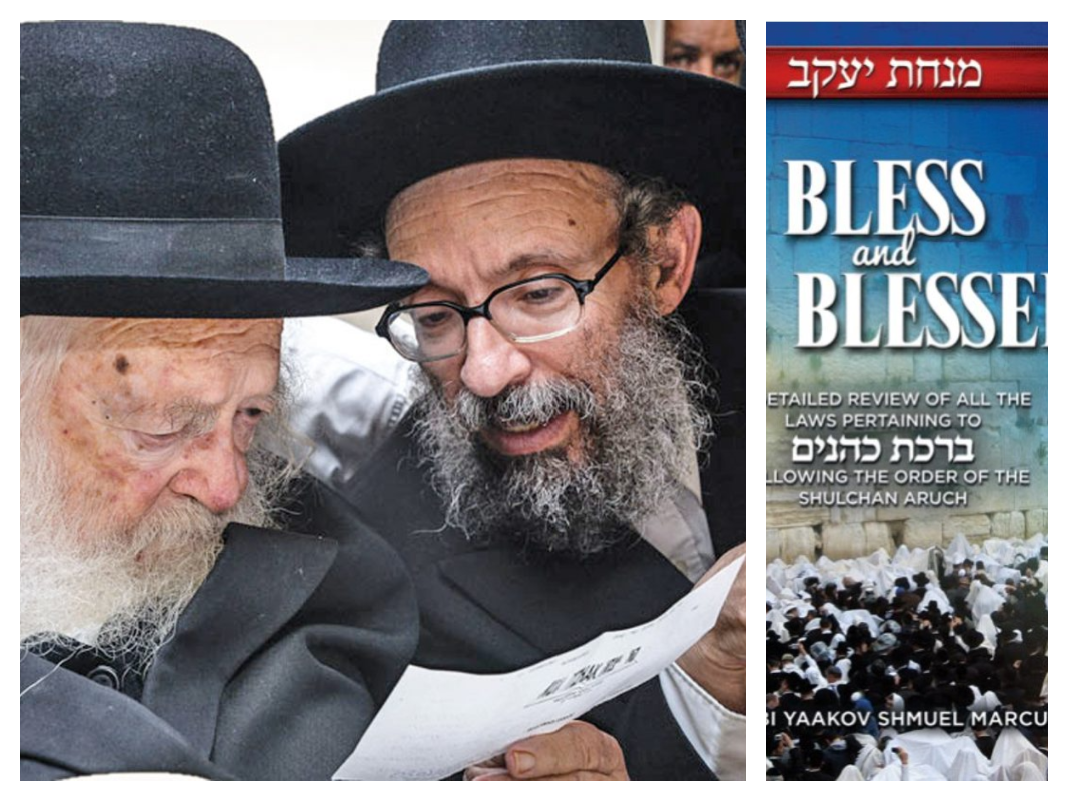By Rabbi Yair Hoffman for 5tjt.com
Recently, I ran into Rav Chaim Kanievsky zatzal’s son in law, Rav Yitzchok Koledetsky shlita lbc”l, who was leaving the Vasikin minyan in the Agudah shul before davening had finished. Where was he headed in the middle of davening?
I had previously translated for him at a number of schools and he gave me a warm shalom aleichem. He then explained (without me asking) that he was headed to the Sefardic Minyan in the trailer in the White Shul parking lot of the White Shul to hear Birchas Kohanim.
Yom Tov is around the corner, and we all need to appreciate the gift that is Birchas Kohanim. And what better way to do that then to learn through Rabbi Yaakov Marcus’s absolutely remarkable sefer on Birchas Kohanim, “Bless and Be Blessed?”
The sefer has 206 pages and is not divided into chapters but rather it contains detailed answers to some 67 questions. It has haskamos and michtavei bracha from Rav Dovid Cohen shlita, Rav Yaakov Forcheimer shlita, Rav Avrohom Schorr shlita, and Rav Yeruchem Olshen shlita. For the more dvanced talmid chochom, he has sources on the bottom of the page along with explanations. It also has an extensive index and a section in the back with a full translation of Birchas Kohanim.
Some interesting rulings:
#56 – May a Kohen who is dishonest in business recite birchas Kohanim? The Rambam in Hilchos Tefillah 15:6 rules that he can. (The Shitos Kamai explains that the blessing comes from hashem and the Kohanim are mere conduits).
#2 – Generally speaking for a minyan – the custom is to allow it to be conducted when there are six who have not davened – with an additional four people who have already davened. Rabbi Marcus cites the opinion of Rav Moshe Shternbuch in Teshuvos v’Hanhagos Vol. IV #36) that for Birchas Kohanim – this should be avoided.
#43 – This question and answer discusses where exactly the recipient of the brachos should be standing. Many people somehow are aware that one must stand face to face with the Kohanim and behind them. Some people do avoid sitting behind a pillar. Technically, this is permitted, however there is a separate reason that Rabbi Marcus himself suggests as to why someone should avoid sitting behind a blocking pillar – to show the chavivus HaMitzvah – that the Mitzvah is beloved to him. He cites this concept earlier (on page 109) from the writings of Rav Eliyahu Pinchas Mireina of Bnei Brak zt”l.
#26- What happens if someone skips even just one word of Birchas Kohanim? Believe it or not, he has not fulfilled the Mitzvah and he must go back from the word that he missed and recite all of them aloud from then on. Also, unlike other brachos and tefilos – Birchas Kohanim may only be recited in Hebrew. If one does so in English or any other language – he has not fulfilled the Mitzvah and it is a bracha levatalah.
In #35 we discover another halachic difference between Chabad practice and that of the Litvish velt. According to standard practice (as cited in the Mishna Brurah 128:64) the person who calls out “Kohanim” whenever there are two or more kohanim present should wait until the majority finish their amains. The Rav Shulchan Aruch recommends that he wait until they all finish their amains.
But what about Rav Kolodetsky, who left the Agudah and went to the Sefardic Minyan ? Did he fulfill a Mitzvah to hear Birchas Kohanim? Rabbi Marcus notes further in question #9 that according the Sefer Chareidim (cited in the Biur Halacha beginning of Siman 128) – there is a Mitzvah also on the part of a regular Yisroel to be blessed. The Ritva on Sukkah 31b rules that there is no Mitzvah for an Yisroel to be blessed and that seems to be the normative psak halacha. However, there are a number of sources that state one should try to be stringent. Rav Aharon Lein Shteinman zt”l was known to rush to Birchas Kohanim when he was in Chutz LaAretz as well.
Another question found in #9. What happens when someone is in the middle of the silent Shmoneh Esreh and all of a sudden birchas kohanim begins? Should he pause? Or may he pause? Rav Moshe Feinstein zatzal writes that he should pause and so does Rav SHlomo Zalman Auerbach zatzal. But Rav ELyashiv is cited in his HaAros on Sotah (the sefer came from recordings) that since most Rishonim do not hold like the Chareidim then he should not make a hefsek in his own Shmoneh Esreh and he would be considered like “the people in the fields” who receive the brachos regardless. Rav Ovadyah Yoseph (Yabia Omer Vol. VII OC #12) comes to the same conclusion as Rav Elyashiv – but that he may do so if he so wishes.
This sefer is clearly a work of love, as the author spent much time researching the topic. I first met Rabbi Marcus in connection to one of his beloved students. However, to my delight I discovered later that he was also the author of the much regarded “Minchas Yaakov” on Meseches Sota. The words he wrote in that first volume apply very much to him – that the shehecheyanu one recites upon the printing of one’s sefer is upon the fulfillment of Mitzvah in Dvarim (31) of kisvu lachem es hashirah hazos velimda lahem sima befihem. It is clear that he treats his students with the same love and tender care as he does his learning. This reviewer believes that no reader will not be moved and inspired by this sefer – aside from gaining a tremendous amount of knowledge.
The reviewer can be reached at [email protected]











